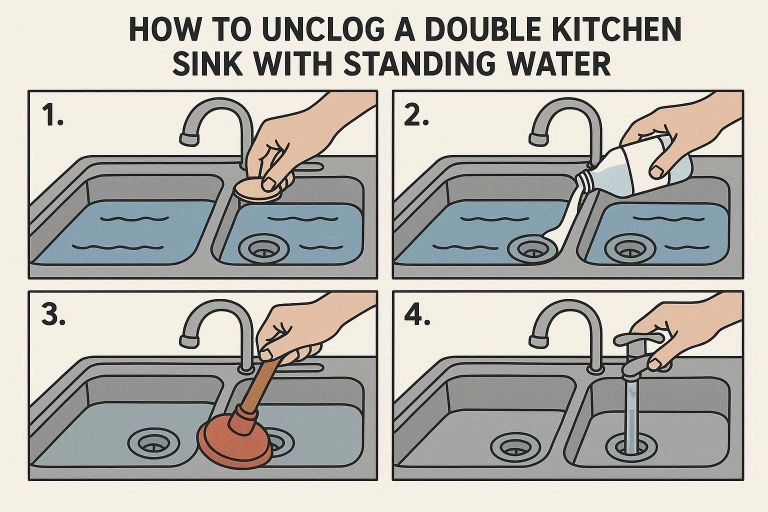A clogged double kitchen sink with standing water is a common, frustrating issue that many homeowners face. Whether you’re dealing with a slow drain or a complete blockage, it’s essential to understand how to address the problem effectively. In this blog post, we’ll walk you through the causes of standing water in your kitchen sink, the tools you need to unclog it, and a detailed, step-by-step guide to solving the issue yourself. Let’s dive in!
Understanding the Issue: Standing Water in Your Double Sink
What is Standing Water in Kitchen Sinks?
Standing water refers to water that remains stagnant in the bottom of your kitchen sink, unable to drain. When your double sink has standing water, it means that there is some form of blockage preventing the water from flowing down the drain properly. This stagnant water can create an unpleasant odor, cause bacteria buildup, and make your kitchen sink unusable until the issue is resolved.
Why Standing Water Happens in Double Kitchen Sinks
Standing water in a double sink typically happens when one or both of the drain pipes are clogged. The most common reasons include the accumulation of food particles, Cleaning Guide for Home & Kitchen grease, soap scum, or other debris inside the drain pipes. In double sinks, standing water can also occur when the two sink basins are connected to the same drainage pipe, and a clog in that shared pipe can affect both sides.
The Importance of Addressing the Issue Promptly
Ignoring standing water can lead to more severe problems, such as unpleasant odors, mold growth, or even water damage if the clog worsens. It’s crucial to act quickly, as a clogged sink can also lead to bigger plumbing issues that might require costly repairs.
Common Causes of Standing Water in a Double Kitchen Sink
Clogged Drains or Pipes
Food debris, grease, soap, and other particles can accumulate in your kitchen sink drain over time, forming a clog. These clogs obstruct the flow of water, causing standing water to build up in your sink. Grease, in particular, is notorious for creating stubborn blockages because it solidifies over time and sticks to the inside of the pipes.
Improper Drainage System or Trap Issues
The P-trap under your kitchen sink could also be to blame for the standing water. The P-trap is designed to hold water to prevent sewer gases from entering your kitchen, but it can easily get clogged with food debris, grease, or other substances. A blockage in the P-trap will stop the water from flowing smoothly down the drain.
Airlock in the Drainage System
Sometimes, air can become trapped in the drainage pipes, forming an “airlock” that blocks the water flow. This can occur if your kitchen sink hasn’t been used for some time or if the drainage pipes are improperly installed. An airlock can create pressure in the pipes, preventing water from draining effectively and causing standing water to form.
Tools You’ll Need to Unclog a Double Kitchen Sink
Before you get started with unclogging your double kitchen sink, you’ll need a few essential tools to tackle the job effectively.
Plunger
A plunger is one of the most common and effective tools for dislodging clogs in sinks. It works by creating suction and pressure to loosen and remove blockages in the drain. When using a plunger, make sure to cover both drain openings if you’re working on a double sink. This helps create the necessary suction for both drains.
Drain Snake or Auger
A drain snake is a long, flexible tool that helps break up clogs deep inside your pipes. It’s especially useful when you can’t reach the clog with a plunger. A drain auger can reach clogs that are further down the drain line and is highly effective at clearing stubborn blockages.
Baking Soda and Vinegar
Baking soda and vinegar create a natural and eco-friendly solution to help break down clogs. When combined, these substances bubble and fizz, helping to break up food debris, soap scum, and grease in the pipes. This method is ideal for clearing minor clogs and also helps freshen up your kitchen sink.
Pipe Wrench
A pipe wrench is necessary for removing the P-trap if the clog is located there. This tool allows you to loosen and remove the trap, giving you access to the blockage so that you can clean it out.
Step-by-Step Guide to Unclog a Double Kitchen Sink with Standing Water
Step 1: Assess the Situation
Start by checking the water level in your sink. If both sides are clogged with standing water, there’s likely a blockage in the main drain line or the shared pipe. If only one side is affected, the clog might be isolated to that particular basin.
Look for visible debris or food particles in the drain openings. If you see any large objects, use your hand (or gloves) to remove them.
Step 2: Try the Plunger
If you don’t see any large debris and the water remains stagnant, grab your plunger. For a double sink, place the plunger over one drain and cover the other with a wet cloth to create a seal. Push the plunger down and then pull it up with force. Repeat this motion for 20-30 seconds.
The pressure from the plunger should break up the clog and allow the water to drain. If this works, you’re all set! If not, move on to the next step.
Step 3: Use Baking Soda and Vinegar
If the plunger doesn’t work, try the baking soda and vinegar method. Pour about half a cup of baking soda into the drain, followed by half a cup of vinegar. You should hear some fizzing as the two ingredients react.
Let the mixture sit for 10-15 minutes to work its magic. After the fizzing stops, rinse the drain with hot water to flush out the debris. This natural solution can break down grease and small blockages, helping to clear the pipes.
Step 4: Use a Drain Snake
If the clog persists, it’s time to bring out the drain snake. Insert the snake into the drain and begin turning the handle. The snake will push through the blockage, breaking it up. Keep turning until you feel resistance break away.
If the snake encounters a tough clog, don’t force it. Gently pull the snake back out and check for debris. You may need to reinsert the snake a few times if the clog is stubborn.
Step 5: Check the P-Trap
If the clog remains unresolved, it might be time to check the P-trap. Use a pipe wrench to loosen the nuts that hold the trap in place. Once removed, clean out any debris inside the trap. This is a common area where grease, food particles, and other debris build up.
Reassemble the trap once it’s clean and check if the water drains properly.
Step 6: Flush with Hot Water
After clearing the clog, pour a pot of hot water down the drain to flush out any remaining debris. Hot water helps clear out any grease or soap buildup that might be stuck in the pipes.
Preventative Tips to Avoid Future Clogs
Regularly Clean the Drain
Make it a habit to clean your sink drains regularly. Pour hot water down the drain once a week to prevent grease and soap buildup. You can also use the baking soda and vinegar method monthly for an extra clean.
Avoid Pouring Grease Down the Sink
Grease can solidify in your pipes, leading to serious clogs. Never pour grease or cooking oil down the drain. Instead, collect it in a jar or container and dispose of it properly.
Use a Sink Strainer
A sink strainer helps prevent large food particles from entering the drain. This simple tool can make a huge difference in reducing the amount of debris that causes clogs.
When to Call a Professional Plumber
Persistent Clogs
If you’ve tried all the DIY methods and the water still won’t drain, it’s time to call in a professional plumber. Persistent clogs may indicate a larger plumbing issue that requires professional tools and expertise.
Major Plumbing Issues
If you suspect there’s a problem with your drainage system or P-trap beyond the blockage (e.g., broken pipes or leaks), a plumber can diagnose and fix the issue before it causes further damage.
Safety Concerns
If you’re uncomfortable using plumbing tools like a drain snake or pipe wrench, or if you encounter any hazards while attempting to fix the problem, it’s best to hire a professional. Plumbing repairs can sometimes be tricky, and safety should always come first.
FAQ
What causes standing water in my double kitchen sink?
Standing water in your double sink is usually caused by clogs, improper drainage, airlocks, or issues with the P-trap. These blockages prevent water from flowing properly down the drain.
Can I use a plunger for both sides of my double sink?
Yes, you can use a plunger for both sides of the sink. Cover the other drain with a wet cloth to create a seal and ensure the pressure works on both sides.
How do I clean the P-trap under my double sink?
To clean the P-trap, use a pipe wrench to remove the trap and clear out any debris. After cleaning, reassemble the trap and check the drainage.
Why won’t my drain snake break through the clog?
If the drain snake encounters resistance, it may be dealing with a tough or deep clog. Don’t force it—try rotating the snake and pulling it back out to clear debris, then reinsert if necessary.
How often should I clean my kitchen sink drain to avoid clogs?
Regular cleaning, at least once a month, helps prevent clogs. You can also run hot water through the drain weekly to keep it clear.
Final Thoughts: Keep Your Kitchen Sink Clean and Clear
A clogged double kitchen sink with standing water is a nuisance, but with the right tools and steps, you can easily resolve the issue yourself. Regular maintenance, such as cleaning the drains and avoiding grease buildup, will help prevent future problems. However, if the clog persists or you’re dealing with a larger plumbing issue, don’t hesitate to call a professional plumber for assistance.
Have you tried unclogging your double sink with standing water? Share your experience in the comments or ask any questions you may have. We’d love to hear from you!

